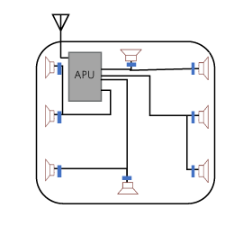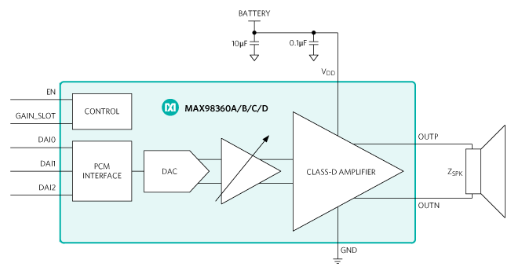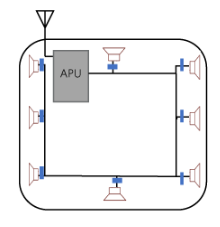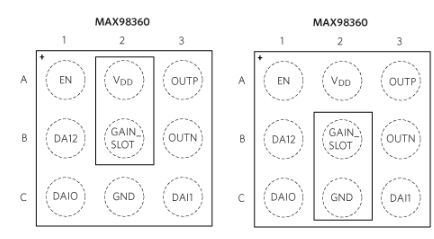The all-encompassing pleasure of surround sound is one of the stimulations of modern film experiences. It is incredible that AR/VR device manufacturers are seeking ways to bring this experience out of the cinema and into the realm of wearable headsets (also known as near-field surround sound). In this article, we will first introduce the limitations of common audio amplifier solutions, and then present an easy-to-use (plug-and-play) micro Class D amplifier, and demonstrate how to use it to achieve this ambitious goal.
Introduction
The screen is a window through which people can see a virtual world. The challenge lies in making that world look real, act real, sound real and feel real. Ivan Sutherland, an American computer scientist and Internet pioneer widely regarded as the "father of computer graphics", concisely expounded on the challenges of creating truly immersive augmented reality or virtual reality (AR/VR) experiences. Although many efforts have been focused on creating stunning visual panoramas, attention is now beginning to shift to further enhancing the audio and haptic components of AR/VR adventures. In fact, Jeffrey Yau, a researcher at Johns Hopkins University in Baltimore, summarized the results of recent experiments on the relationship between sound and touch. We listen with our ears and feel with our skin, but our brain may combine this information in a specific way. The frequency information from the two senses always seems to be combined. For developers, this might mean that future improvements in AR/VR audio and haptic aspects will take place simultaneously rather than independently and in parallel.
In this design solution, we have considered the types of audio experiences that high-end AR/VR device manufacturers hope to offer, as well as the challenges of achieving this goal within the limited space constraints of wearable headsets. Before proposing an efficient, plug-and-play digital Class D amplifier, we discussed the significance of haptic feedback for AR/VR audio experiences, which can be easily expanded to achieve the desired audio and haptic experiences in a space-saving, compact solution.
近场环绕声
Surround sound is defined as a stereo system that involves three or more speakers surrounding the audience to provide a more realistic modern cinema effect. It uses a 7.1 configuration (3 left, 3 right, one center channel and one subwoofer) to create a more realistic surround sound experience. The task of placing eight speakers (plus an amplifier) in different positions is no small matter, even in a spacious room, to provide the best sound quality. It is incredible that AR/VR device manufacturers are now seeking to reproduce the same near-field surround experience in wearable headsets.
Although this may sound unlikely, they are also looking for ways to use haptic joysticks to create audio synchronization reverb, thereby providing the wearer with a more satisfying sensory experience. Anyone who goes to the cinema to watch a movie or to the auditorium to listen to a classical orchestra knows that sound is only part of the experience. The overlapping vibration felt by the audience greatly enhanced the overall experience.
Head-mounted 3D audio
Facing the arduous task of creating an immersive 3D audio design in a head-mounted installation, the key to achieving this goal lies in choosing the appropriate audio amplifier to meet the design specifications. Interconnecting up to eight speakers within the framework of a wearable head-mounted device requires the use of an audio IC, which not only adopts a micro-package but also allows for direct circuit board wiring. The amplifier should be as efficient as possible (90% or higher) and be capable of operating at the lowest possible supply voltage. This helps to minimize power consumption, thereby extending the battery life of the headphones. Like all modern audio applications, high-fidelity sound quality (high PSRR, low noise and wide dynamic range) is almost beyond description.
Another key specification of the amplifier is its EMI performance. Because multiple traces traverse different lengths, the audio amplifier must suppress unwanted signal frequencies, which may become perceptible if passed to the speaker. It seems that meeting the audio requirements is not strict enough; the amplifier must also meet the fast conduction time needed for synchronous connection with the haptic joystick. If the conduction time exceeds a few milliseconds, the tactile circuit must always remain in an awakened state, even when not in use, which will waste power. By using an amplifier with a fast conduction time, the tactile circuit is activated only when needed.
A typical but not insignificant solution
To meet the requirements of high efficiency, a Class D audio amplifier needs to be used. These devices are provided in different forms, operate under different power supply voltages, and have different efficiency levels. Figure 3 shows that <> I2S are connected to the S input of the audio processing unit. Class D speaker amplifiers typically require four independent I2S ports.

A simpler and smaller solution
The IC shown in Figure 4 addresses all aspects of the previously considered design requirements by using a simpler and smaller solution.




Figure 7. Connect GAIN_SLOT to VDD or GND to obtain the desired gain setting.
| Gain_Slot | My 2S/ left-aligned gain (dB) |
| Connect to ground | 12 |
| Irrelevant | 9 |
| Connect to VDD | 6 |
| Connect to VDD (via a 100kΩ resistor) | 3 |
| Connect to ground (via a 100kΩ resistor) | -3 |
For applications that require variable gain Settings, GAIN_SLOT pins can be easily routed using a tiny trace of 2mil and a 2mil gap, as shown in Figure 8.

This IC operates on only one power supply voltage and has a working temperature range of 2.5V to 5.5V. When seeking to extend battery life, operating at an efficiency of up to 92% is a significant advantage. It can accept input logic voltage levels as low as 1.2V (which means no level converter is needed), but it is robust enough to withstand voltages up to 5.5V. Another useful feature of this IC is that if the DAIx pin remains at A low level, it will automatically enter a 1.5μA ultra-low power standby mode. This can be used to significantly reduce power consumption in applications where host-free GPIOs can be used to control EN pins. Another advantage is that, due to its extremely fast conduction time of 1ms (four times faster than similar Class D amplifiers), it can wait in this low-power standby mode even when used with LRA haptic drivers. It should be noted that the EN pin can achieve additional energy-saving effects by placing the IC in the off mode that only absorbs 15nA of current.
Summary
Designers of AR/VR devices continue to break through the boundaries between reality and virtuality. One way they achieve this is by offering an outstanding audio and tactile experience. Multi-channel audio systems, once the exclusive domain of cinemas or home theaters, are now being incorporated into high-end AR/VR headsets. In this article, we discussed the requirements for audio amplifiers to achieve this. We present a compact and flexible "plug-and-play" Class D digital audio amplifier, whose physical and electrical specifications make it an ideal choice for this application. In addition to AR/VR applications, it is also applicable to tablets, laptops, Internet of Things devices and smart speakers.
免责声明: 本文章转自其它平台,并不代表本站观点及立场。若有侵权或异议,请联系我们删除。谢谢! Disclaimer: This article is reproduced from other platforms and does not represent the views or positions of this website. If there is any infringement or objection, please contact us to delete it. thank you! |


